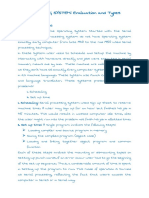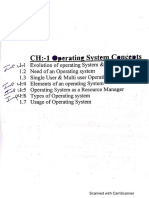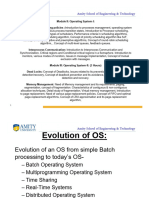0% found this document useful (0 votes)
81 views11 pagesOperating System Modes Explained
There are three main modes of operating systems: batch processing, multiprogramming, and multiprocessing. Batch processing groups jobs into batches that are executed sequentially with no priority. Multiprogramming allows multiple independent programs to run simultaneously on a single processor by rapidly switching between them. Multiprocessing uses two or more CPUs that can work independently in parallel.
Uploaded by
shiladitya89Copyright
© © All Rights Reserved
We take content rights seriously. If you suspect this is your content, claim it here.
Available Formats
Download as PPTX, PDF, TXT or read online on Scribd
0% found this document useful (0 votes)
81 views11 pagesOperating System Modes Explained
There are three main modes of operating systems: batch processing, multiprogramming, and multiprocessing. Batch processing groups jobs into batches that are executed sequentially with no priority. Multiprogramming allows multiple independent programs to run simultaneously on a single processor by rapidly switching between them. Multiprocessing uses two or more CPUs that can work independently in parallel.
Uploaded by
shiladitya89Copyright
© © All Rights Reserved
We take content rights seriously. If you suspect this is your content, claim it here.
Available Formats
Download as PPTX, PDF, TXT or read online on Scribd
/ 11

























































